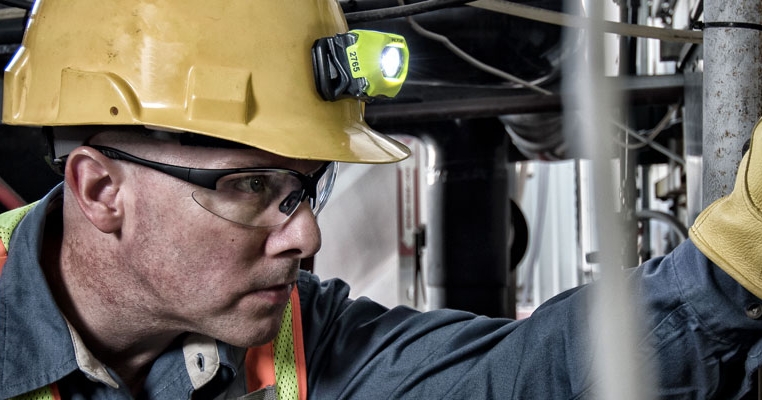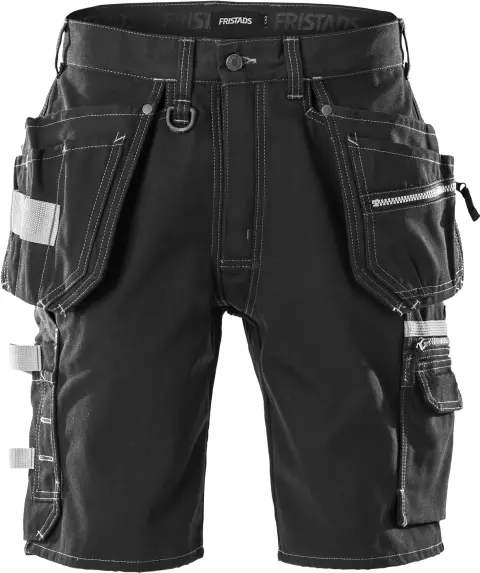
Essential PPE in the Food Industry: What You Need to Know
Overwhelmed by PPE options for food safety? Master your PPE selection for food workers safety with these practical tips.

Get 20€ off on your first order!
Selecting the right headlamp for your work is essential for both safety and efficiency. In this article, we’ll explore the key differences between LED and halogen headlamps, helping you understand which option best fits your needs.
Whether you’re looking for durability, brightness, or energy efficiency, we’ll guide you through the factors to consider.
By the end, you’ll have all the information needed to make a confident choice.
Plus, we’ll point you to the next step by recommending complementary safety gear to enhance your protection. Keep reading to find the perfect headlamp solution for your work environment.
LED headlamps use light-emitting diodes to produce light, offering superior color temperature and beam consistency compared to traditional lighting technologies. Known for their efficiency, LEDs offer bright, focused beams while consuming minimal energy. They are particularly useful in demanding environments where consistent lighting is essential.
Key features include:
Halogen headlamps operate using a filament enclosed in halogen gas, producing light when heated. These lamps generate heat, which contributes to their energy profile and may factor into certain applications. While traditional, they remain a popular choice for their affordability and familiarity.
Advantages of halogen include:

| Feature | LED Headlamps | Halogen Headlamps |
| Color Temperature | 5000-6500K, replicating daylight | 3000-3500K, warm and yellowish light |
| Brightness | Up to 3000 lumens, ideal for detailed tasks | 700-1500 lumens, suitable for general use |
| Lifespan | 10,000 – 50,000 hours | 2,000 – 6,000 hours |
| Energy Efficiency | High, requires less power | Moderate, higher energy consumption |
| Durability | Resistant to shock, vibrations, and extreme weather | Less durable, susceptible to damage from impact |
| Cost | Higher initial cost, lower maintenance expense | Lower initial cost, higher long-term replacement cost |
Evaluate the required brightness for your work environment. For example, tasks like detailed inspection or electrical work often require headlamps with at least 1000 lumens, while general tasks may only need 300-700 lumens. For tasks requiring precision, such as electrical work or inspection, the high lumen output of LED headlamps is ideal. Halogen headlamps, while less intense, are sufficient for general tasks like walking or working in moderately lit spaces.
LEDs are particularly well-suited for construction or outdoor projects due to their resilience. Halogen headlamps perform well in standard environments and may be less optimal for highly demanding conditions. Learn more about choosing headlamps for construction.
If you prioritize long-term savings, LEDs are a better investment due to their energy efficiency and durability. Halogens provide a cost-effective upfront option, while LEDs deliver long-term savings through reduced energy usage and maintenance needs.
LEDs are perfect for:
Halogens are suitable for:
To make the best choice, evaluate your work needs, environment, and budget to align with the unique strengths of each type. Summarizing from the chart, LEDs are ideal for intense and durable applications, while halogens are a budget-friendly option for moderate usage.
Both LEDs and halogens provide unique benefits, making them suitable for different types of tasks depending on your specific needs.
Explore our curated selection of headlamps, headlights, and head torches, including popular models renowned for durability and efficiency. For additional guidance, consult related resources like “How to Determine the Ideal Lumen Output for Your Work Headlamp”.
To complement your headlamp, consider pairing it with hard hats and safety helmets. These provide comprehensive head protection and are particularly valuable in demanding work conditions. For guidance on selecting the right headgear, refer to our article on “Hard Hats and Safety Helmets: Selecting the Right Headgear”.
We hope this guide has helped you understand the key differences between LED and halogen headlamps, from brightness and energy efficiency to durability and cost. Whether you’re working in industrial environments or outdoor settings, we’re here to support your headlamp needs.
Explore our headlamps category from trusted brands, ensuring you find the right fit for your work.
Also, explore related articles such as “Bump Caps: Everything You Need To Know”.
Have questions or need help choosing the perfect headlamp? Don’t hesitate to reach out—we’re always here to ensure you have the right equipment for safety and efficiency in every task.
– The Droppe Team
Yes, LED headlamps are perfect for outdoor activities, especially with waterproof models designed for unpredictable weather.
Yes, halogen headlamps have a lower upfront cost, making them more affordable initially.
Battery life in LED headlamps varies, but they typically last longer than halogen headlamps due to their energy efficiency.
LED headlamps usually don’t require bulb replacement since the LEDs last for thousands of hours.
Yes, LED headlamps are more durable, resistant to shocks, vibrations, and extreme weather conditions.
Thank you! You've signed up for our newsletter.



















Overwhelmed by PPE options for food safety? Master your PPE selection for food workers safety with these practical tips.

Struggling to maintain clear vision in demanding environments? This guide is here to help. By the end, you’ll know exactly...

Electricians across Europe face unique challenges that require reliable safety glasses to ensure both protection and efficiency. Whether safeguarding against...

Overwhelmed by PPE options for food safety? Master your PPE selection for food workers safety with these practical tips.

Struggling to maintain clear vision in demanding environments? This guide is here to help. By the end, you’ll know exactly...

Electricians across Europe face unique challenges that require reliable safety glasses to ensure both protection and efficiency. Whether safeguarding against...
Get 20€ off on your first order!
Save 30% by buying directly from brands, and get an extra 10€ off orders over €100
Save 30% by buying directly form brands, and get an extra 10€ off orders over €100